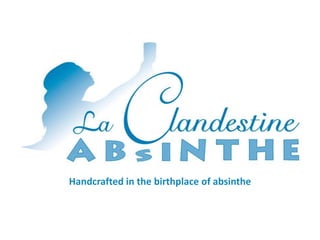
La Clandestine Presenttation 010912
- 1. Handcrafted in the birthplace of absinthe
- 2. Swiss absinthe regulations • Absinthe must be distilled and not made in the cold mix method • It cannot contain any artificial coloring • No sugar added Switzerland is the only nation with strict standards for absinthe
- 3. La Clandestine Absinthe Handcrafted in Couvet, Switzerland, the birthplace of absinthe, to a moonshiner’s 1935 recipe
- 4. La Clandestine Absinthe Distilled by Claude-Alain Bugnon, winner of five consecutive Absinthiades Golden Spoons
- 5. La Clandestine Absinthe Swiss terroir: A unique combination of micro-climate, geography and soil ideal for Grande wormwood production
- 6. La Clandestine Absinthe Produced in very small batches (88 liters) using 10+ different plants including seven locally grown alpine ingredients
- 7. La Clandestine Absinthe Plants are married and macerated in neutral grain alcohol and distilled in copper alembics to 152 proof
- 8. La Clandestine Absinthe Colorless distillate is reduced to 106 proof using Swiss mountain stream water and bottled by hand
- 9. La Clandestine Absinthe Watch Claude-Alain and his family at work via the webcam
- 10. La Clandestine Absinthe Widely regarded as the world’s finest absinthe - award winner
- 11. La Clandestine Absinthe Top social media presence: High Facebook interaction, very influential Twitter ratings and acked by world’s #1 absinthe blog
- 12. Handcrafted in the birthplace of absinthe Appendix
- 13. La Clandestine Brand Description La Clandestine is hand-crafted in Couvet, Switzerland, the birthplace of absinthe. The brand heritage dates back to 1935, and its small-batch production methods go back to the origins of absinthe in the 18th century. White (or “blanche”) absinthe first exists as a clear spirit before a second coloring step transforms it into green absinthe. Thus, blanche absinthes are the true originals. When absinthe was wrongly banned in Switzerland in 1910, farmers and their wives secretly made absinthe at home for family and friends, returning to the clear style, perhaps to avoid detection. La Clandestine, the world’s most loved blanche, comes from this era and was first distilled by Charlotte Vaucher in 1935. In 2000, Claude-Alain Bugnon received the recipe from Charlotte’s nephew and continued illegal production until absinthe could once again be made openly. Claude-Alain and his wife Karine make La Clandestine in Couvet, the small village in the foothills of the Alps where absinthe was first distilled commercially in the second half of the 18th century. They use the famed local Grande wormwood as well as the unique Swiss savoir faire that comes from well over 200 years of continuous manufacture of absinthe. Claude-Alain is recognized as Europe’s leading absinthe distiller, with more awards than any other, and his absinthes are hand-sold to some of the top bars and retailers in 25 countries.
- 14. Tasting Prose The best absinthes should rarely, if ever, be consumed straight and have always been distilled at high strengths in order to be mixed with water. For the perfect serve, slowly add 3 to 4 parts iced water from a carafe or absinthe fountain. With La Clandestine, there is no need to pour over a sugar cube and, of course, absolutely no need to burn it! The “Louche”: When iced water is added, it turns milky white with “rumbling thunderclouds” appearing as if by magic and dancing in the glass. This louche has been compared to the thunderclouds above Lake Geneva. As crystal clarity yields to the thunderclouds, the aromas take on added complexity and fill the room. Often described as “fresh as an alpine meadow,” its bouquet of flowers and herbs are delicate and masterfully balanced. La Clandestine is “almost uniquely versatile.” Its elegant floral nature appeals both to those just starting their absinthe journey as well as to long-time absinthe connoisseurs. A perfect absinthe for the classic drip serve, it does not have the sometimes overpowering herbaceous notes of some vertes. This makes it a perfect ingredient in classic cocktails such as Death in the Afternoon and in contemporary cocktails such as the Clandestino.
- 15. Tasting Notes: La Clandestine Appearance Clarity: Crystal clear Legs: Slow, small and long Color: Clear, turning milky white when louched Nose Condition: Elegant Development: Initially sweet floral, further abundant herbal notes when louched Character: A perfect balance of the absinthe “trinity” (wormwood, anise, fennel) Palate Sweetness: Initial honey sweetness giving way to wormwood’s mild bitterness Body: Very full-bodied Intensity: Medium Mouthfeel: Smooth neat, even at 53%, even smoother and luscious louched Character: Fresh floral notes like an alpine meadow, with vanilla, rose petals, a touch of mint and spice, and perfectly balanced with no one flavor dominating Alcohol: Subtle, even at 53% Finish: Clean and long lasting Conclusions Quality: Outstanding example of a Swiss blanche Origin: Couvet, Val-de-Travers, Switzerland